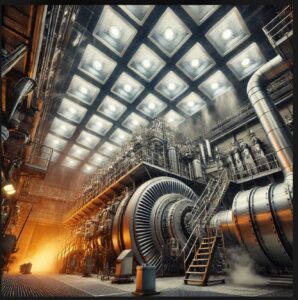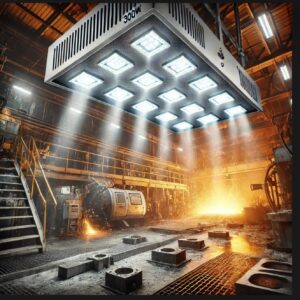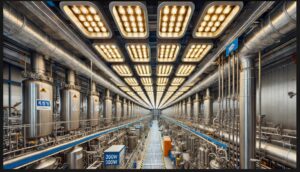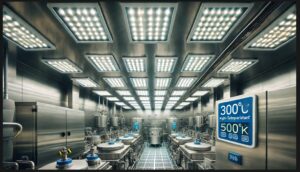-
- Consistent Light Output: LEDs do not experience rapid lumen depreciation, meaning they maintain their brightness for a much longer period than traditional lamps, ensuring consistent illumination throughout their lifespan.
-
- Shorter Lifespan: Incandescent bulbs typically last 750 to 1,000 hours, fluorescent lamps last around 7,000 to 15,000 hours, and metal halide lamps last about 10,000 hours. These shorter lifespans lead to more frequent replacements and higher maintenance costs.
- Fragility: Traditional bulbs, particularly incandescent and fluorescent, are more prone to damage from vibration and impact. Fluorescent lights also contain glass tubes that can break easily, posing a safety hazard in industrial environments.
3. Light Quality and Performance
-
- Instant Light Output: LEDs provide instant light when switched on, without the warm-up time that some traditional lights require (e.g., metal halide or fluorescent lamps). This is particularly beneficial in industrial environments where immediate illumination is necessary.
- High CRI (Color Rendering Index): LEDs offer a higher CRI (typically 80-90), which means they produce light that is more true-to-life and enhances the ability to distinguish colors. This is especially important in quality control, inspection, and high-precision tasks in glass production.
- Dimmability and Customization: LEDs are highly customizable, with many models offering dimming capabilities and adjustable color temperatures. This adaptability ensures optimal lighting for various tasks, whether high-intensity illumination is needed for detailed work or softer, warmer light for more general areas.
-
- Warm-Up Time: Fluorescent and metal halide lamps require warm-up time before reaching full brightness, which can be a drawback in industrial applications where immediate light is necessary.
- Lower CRI: Incandescent and fluorescent lights tend to have lower CRI values (typically around 60-80), which can distort colors and make it harder to accurately assess materials or products in tasks like inspection and quality control.
- Limited Customization: Traditional lighting systems typically offer fewer options for customization in terms of light intensity and color temperature. This can result in suboptimal lighting conditions for specific tasks.

4. Environmental Impact
-
- Eco-Friendly: LEDs are free of toxic chemicals, such as mercury (found in fluorescent and metal halide lamps), making them safer to use and dispose of. Their energy efficiency also contributes to a lower carbon footprint.
- Recyclable Materials: LEDs are made from recyclable materials and can be disposed of in an environmentally responsible manner, helping reduce the amount of waste in landfills.
- Lower Carbon Emissions: Due to their lower energy consumption, LEDs help reduce greenhouse gas emissions and energy production demands, contributing to overall sustainability goals.
-
- Toxic Materials: Fluorescent and metal halide lamps contain mercury, a hazardous substance that poses a risk to health and the environment if the lamps are broken or not disposed of properly.
- Higher Carbon Footprint: Because traditional lighting uses more energy, it indirectly contributes to higher carbon emissions and increased environmental impact, especially in industrial settings that require large quantities of light.
5. Cost of Operation
-
- Lower Operating Costs: While LEDs may have a higher initial cost, their long lifespan, low energy consumption, and minimal maintenance requirements make them far more cost-effective in the long term.
- Energy Savings: The significant reduction in energy usage leads to lower electricity bills, making LEDs an ideal choice for large facilities or areas that require continuous or high-intensity lighting.
-
- Higher Operating Costs: Traditional lighting fixtures have higher operating costs due to frequent bulb replacements, higher energy consumption, and the need for more intensive cooling systems. For example, the cost of operating a metal halide lamp can be two to three times higher than an LED lamp over its lifetime.
- More Frequent Maintenance: Traditional lighting systems require more maintenance, including ballast replacements for fluorescent lamps and occasional re-lamping for incandescent bulbs. This results in more labor costs and downtime.
6. Suitability for Harsh Environments
-
- Ideal for Harsh Environments: LEDs are more resistant to extreme temperatures, moisture, and physical impacts, making them perfect for industrial settings such as glass manufacturing, mining, or warehouses.
- Dust and Water Resistance: Many industrial LED fixtures are rated with high IP (Ingress Protection) and IK (Impact Protection) ratings, ensuring they can withstand exposure to dust, water, and physical impacts.
-
- Less Durable in Harsh Environments: Incandescent and fluorescent bulbs are more vulnerable to damage from temperature extremes, moisture, and physical impact. For example, metal halide lamps often require more careful handling due to their fragility.
In real-world applications, LED lighting far outperforms traditional lighting systems in terms of energy efficiency, lifespan, performance, and environmental impact. LEDs provide superior durability, customizable light output, and significant cost savings, especially in industrial and commercial settings. Although traditional lighting technologies have been used for many years, they are increasingly being replaced by LEDs due to their clear advantages in modern, energy-conscious industries. By switching to LED lighting, businesses can not only improve operational efficiency but also contribute to a more sustainable future.

Case study: Successful integration of high-temperature LED lighting in a float glass manufacturing facility
Overview
A leading float glass manufacturing facility, known for producing high-quality glass products used in automotive and architectural applications, faced several challenges related to its lighting system. The facility’s production areas, including the furnace, float bath, annealing lehr, and inspection zones, experienced extreme heat, dust, and harsh environmental conditions. The existing lighting infrastructure, which consisted of traditional metal halide and fluorescent fixtures, was often inadequate for these tough conditions, resulting in frequent failures, increased maintenance costs, and poor visibility.
The company decided to replace its outdated lighting system with high-temperature-resistant LED lighting to enhance operational efficiency, reduce maintenance, and improve visibility and safety. This case study highlights the successful integration of LED lighting solutions and the resulting improvements in the manufacturing process.
Challenges Faced by the Facility
- Frequent Lighting Failures: The existing metal halide and fluorescent lights frequently burned out due to the extreme heat (up to 200°C) in key areas, including the float bath and annealing lehr. This resulted in increased maintenance costs and downtime, disrupting production schedules.
- Poor Light Distribution and Glare: The traditional lights provided uneven illumination, leading to areas of shadow and glare. Workers in high-precision areas, such as glass inspection stations, struggled with inconsistent lighting that hampered defect detection.
- High Energy Consumption: The facility’s lighting system consumed large amounts of energy, resulting in high electricity bills. The heat generated by traditional lighting fixtures also required additional cooling systems, further adding to energy costs.
- Health and Safety Concerns: The frequent failure of traditional lighting in high-heat areas posed safety risks to workers, especially when lights went out unexpectedly in critical zones. The glare and flickering from metal halide lamps also caused eye strain and discomfort.
Solution: High-Temperature LED Lighting Integration
To address these challenges, the facility decided to replace all traditional lighting with high-temperature-resistant LEDs. The integration process was carried out in stages to ensure minimal disruption to the production process.
Key Features of the LED Solution:
- Heat-Resistant LED Fixtures: The facility selected LEDs designed specifically for high-temperature environments. These fixtures were rated to operate at temperatures up to 250°C, making them suitable for areas near the furnace and float bath where extreme heat was prevalent.
- Energy-Efficient LED Technology: The new lighting system used LEDs that consumed significantly less energy than the previous metal halide and fluorescent lamps. The LED fixtures were designed to provide the same level of illumination while reducing power consumption by up to 60%.
- Customizable Light Output: The LED fixtures had dimming capabilities, allowing the lighting intensity to be adjusted according to specific production stages. Bright, high-intensity lighting was used in the furnace and float bath areas, while softer, more diffuse light was used in inspection and quality control areas.
- Durable and Long-Lasting: The LED fixtures offered a lifespan of over 50,000 hours, significantly reducing the frequency of replacements and the associated downtime and maintenance costs.
- Anti-Glare and Uniform Light Distribution: The LEDs were equipped with diffusers and anti-glare lenses, ensuring even illumination across the production areas and minimizing shadows and glare. This helped improve visibility and safety, especially in high-precision tasks such as glass inspection.
Implementation Process
- Site Assessment and Planning: The facility’s lighting requirements were carefully assessed by a team of lighting engineers. A detailed plan was developed to install LED lighting across key production areas, including the furnace, float bath, annealing lehr, and inspection zones.
- Fixture Selection and Customization: The lighting fixtures were selected based on their ability to withstand high temperatures, their energy efficiency, and their suitability for different lighting tasks. Customizable LED units with dimming and color temperature control were chosen for the inspection areas to enhance visibility for quality control.
- Installation and Testing: The installation was done in stages to avoid disrupting production. The first stage focused on replacing the lighting in the furnace and float bath areas. The second stage involved replacing lights in the annealing lehr and inspection zones. Once installed, the new LED system was thoroughly tested to ensure it met the required lighting levels and operated smoothly under high-heat conditions.
- Employee Training: Workers were trained on the new lighting system, including how to adjust the light intensity and color temperature for different tasks. The facility also provided training on the benefits of energy-efficient lighting and how the system would help improve visibility and safety.
Results
1. Improved Lighting Performance
- Enhanced Visibility and Safety: The new high-temperature LEDs provided uniform, bright lighting without flickering or glare. Workers in high-precision areas, such as the inspection zones, reported better visibility and were able to detect glass defects more effectively. The even distribution of light also improved safety by reducing areas of shadow, particularly near heavy machinery.
- Reduced Eye Strain: The elimination of glare and flickering from the previous metal halide lamps significantly reduced eye strain for workers, leading to improved comfort and productivity.

2. Energy Savings and Reduced Operating Costs
- Lower Energy Consumption: The LED lighting system reduced energy consumption by up to 60% compared to the old lighting system. This led to a substantial decrease in the facility’s monthly electricity bills, which had been high due to the inefficient energy use of metal halide and fluorescent lamps.
- Cost Savings on Cooling: The reduced heat output from the LED fixtures also lowered the load on the facility’s air conditioning and cooling systems, contributing to further energy savings.
3. Extended Lifespan and Reduced Maintenance
- Longer Operational Life: The LEDs’ long lifespan of 50,000 hours meant that the facility no longer needed to replace bulbs every few months. This saved on both labor costs and the cost of replacement fixtures.
- Reduced Downtime: The facility experienced significantly less downtime as a result of lighting failures. The improved durability and longer lifespan of the LEDs ensured that lighting remained consistent throughout the production process.
4. Environmental Benefits
- Lower Carbon Footprint: The energy savings from the LED lighting system resulted in a reduced carbon footprint for the facility. The LEDs’ energy efficiency and lack of toxic chemicals (e.g., mercury) further contributed to the company’s sustainability goals.
- Recycling and Disposal: The LEDs were free of hazardous materials, unlike the metal halide lamps, which contained mercury. This simplified the disposal process and contributed to the facility’s efforts to reduce environmental impact.
(To Be Continued)



